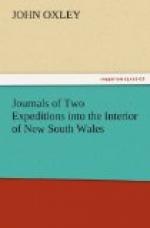Nh-air, The eyebrows.
Whada, The ears.
Ulan-gar,) The head.
Nat-tang,)
Anany, The beard.
Morro, The nose.
Er-ra, The teeth.
Mill-a, The eyes.
Narra, The fingers.
Bulla-yega, The hair of the head.
Chu-ang, The mouth.
0-ro, The neck.
Bargar, The arms.
Ben-ing, The breast.
Bur-bing, The belly.
Mille-aar, The loins.
Dha-na, The thighs.
Wolm-ga, The knees.
Dhee-nany, The feet.
Dhu-a, The back.
Mor-aya, Bones worn in the cartilage of the
nose.
Mada, Skins, with which they are clothed.
Wamb-aur, Scars, raised for ornament, or distinction,
on
their bodies.
Gum-iil, Girdles worn round the body.
Un-elenar, One night.
Gow, Woman.
Mar-o-gu-la, Another tribe.
Mem-aa, A native man.
Wam-aa, A kind of hornet’s-nest, which
they eat.
Warenur, Fire.
Curr-eli, Timber, or trees.
Galu-nur, Thistles, the roots of which they
eat.
Gulura, The moon.
Yandu, Sleep.
Galen-gar,)
Ori-al, ) Stone hatchets.
Ta-wi-uth,)
The above were all the words the meaning of which we could clearly comprehend: the words used by the natives on the coast to express the same objects have not the remotest resemblance to the above.
April 28.—Fine clear mild weather. Proceeded with the remainder of the baggage to join the boats down the river; arrived at Lewis’s Creek, which, although nearly dry when crossed by Mr. Evans in 1815, is now a considerable stream. The distance from the depot is about nine miles; the country on both banks of the river low but good: the upper levels would afford excellent grazing, but the soil is of inferior quality: the points of the low hills end alternately on each side the river. The land up both banks of Lewis’s Creek is very rich, and covered with herbage. The boats had come safely down the river, although the large boat grounded once; the river appears to me to be from three to five feet above its usual level.
Several specimens of crystallized quartz were found on the adjoining hills, also some small pieces of good iron ore.
April 29.—Proceeded on our journey down the river, directing the boats to stop at the creek which terminated Mr. Evans’s former journey. The country through which we passed this day in every respect resembles the tracts we have already gone over. The crowns and ridges of the hills are uniformly stony and barren, ending as before alternately on each side of the river; the greater proportion of good flat land lies on the south side of the river; there are however very rich and fertile tracts on this side. After riding about eight miles, we ascended a considerable hill upon our right, from




